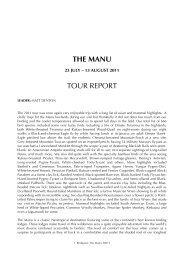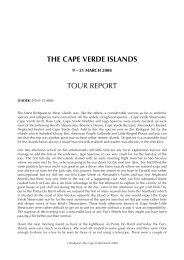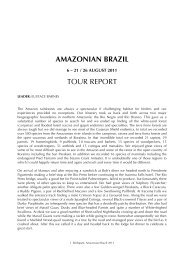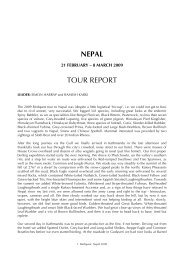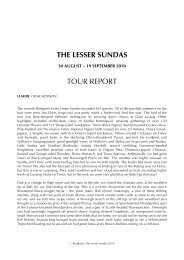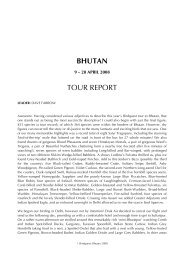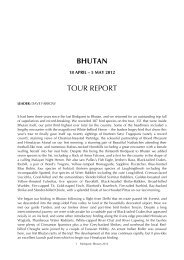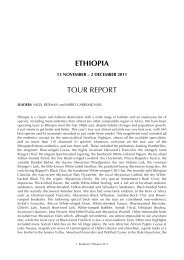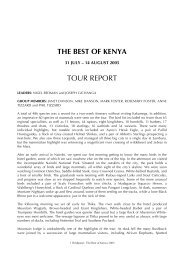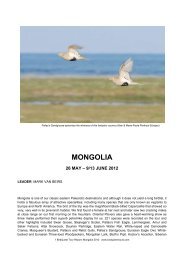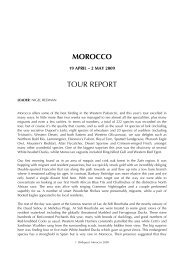SPITSBERGEN TOUR REPORT - Birdquest
SPITSBERGEN TOUR REPORT - Birdquest
SPITSBERGEN TOUR REPORT - Birdquest
You also want an ePaper? Increase the reach of your titles
YUMPU automatically turns print PDFs into web optimized ePapers that Google loves.
TETRAONIDAE<br />
Rock Ptarmigan Lagopus mutus: Excellent scope views of two males on the rocky hillside above<br />
Blomstrandhalvøya and superb views of two males and a female on the boulder slopes at<br />
Bockfjorden. The males were still in their all-white winter dress and easy to spot, but the<br />
female was extremely cryptic.<br />
CHARADRIIDAE<br />
Common Ringed Plover Charadrius hiaticula: A pair at Ny Ålesund and a pair at the Sorgfjord remain<br />
our only observations. This is a rather scarce breeding bird in Spitsbergen, with a<br />
population of only 50-400 pairs.<br />
SCOLOPACIDAE<br />
Sanderling Calidris alba: Great views of nine birds, mostly in full breeding plumage, on the beach at<br />
the Sorgfjord. This is another very scarce breeding wader in Spitsbergen, where the total<br />
population is estimated at only 20-100 pairs.<br />
Purple Sandpiper Calidris maritima: Much the commonest breeding wader in Spitsbergen, present at<br />
most of our landing sites, but remarkably cryptic in its rather sombre breeding dress. Birds<br />
were observed in ‘song flight’ and courtship display on several occasions. The “one wing<br />
lifting” display was well worth witnessing at close range. The Spitsbergen breeding<br />
population is estimated at 2,000-10,000 pairs.<br />
Dunlin Calidris alpina: Just two in the Longyearbyen area upon arrival in the archipelago. Only 100-<br />
200 pairs of Dunlin breed in Spitsbergen, but the population appears to be increasing.<br />
Ruddy Turnstone Arenaria interpres: Just a single bird in breeding plumage was noted in flight upon<br />
leaving the Isfjord. Yet another scarce breeding wader in Spitsbergen, where there are<br />
reckoned to be only 50-500 pairs.<br />
PHALAROPODIDAE<br />
Red Phalarope (Grey Phalarope) Phalaropus fulicaria: Cracking views of eight in the Andøyane<br />
Islands were followed by observations of a pair at the Sorgfjord, one at Fuglesangen, two<br />
at Prins Karls Forland at a single at Eidembukta. Definitely one of the star attractions for<br />
the birders, and vastly more attractive as ‘Red Phalaropes’ in their breeding plumage than<br />
as the ‘Grey Phalaropes’ that we are more accustomed to seeing further south. Between<br />
200 and 1,000 pairs breed in Spitsbergen.<br />
STERCORARIIDAE<br />
Pomarine Skua (Pomarine Jaeger) Stercorarius pomarinus: One was seen by Stewart in the Hinlopen<br />
Strait upon approaching the Alkefjellet and we all saw one at the edge of the pack ice on<br />
Polar Bear day. Both were light morph birds with full tail-streamers. These were<br />
presumably non-breeding birds, as the nearest known breeding grounds are in Novaya<br />
Zemlaya. The scientific epithet is derived from the Greek poma, a lid and rhinos, the<br />
nose, as this species develops a sheath or cover over the nostrils during the breeding<br />
season.<br />
Arctic Skua (Parasitic Jaeger) Stercorarius parasiticus: Much the commonest skua in Spitsbergen,<br />
present throughout the areas that we visited, and showing very well on many occasions.<br />
We witnessed some spectacular aerial chases, with up to four birds harassing a single<br />
Black-legged Kittiwake. The great majority were light morph birds, although there were<br />
one or two intermediate and dark morph individuals. (Dark morph birds are much<br />
commoner at lower latitudes, e.g. in Scotland). The Spitsbergen breeding population is<br />
estimated at 1,000-2,000 pairs.<br />
Long-tailed Skua (Long-tailed Jaeger) Stercorarius longicaudus: We had superb views of a breeding<br />
pair near the old marble mine at Blomstrandhalvøya. Only a few pairs of Long-tailed<br />
Skuas breed in Spitsbergen, presumably because of the complete absence of lemmings,<br />
their preferred prey during the breeding season.<br />
6 <strong>Birdquest</strong>: Spitsbergen 2007




